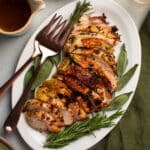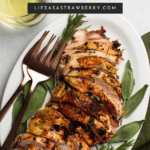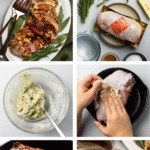Description
This easy herb roasted turkey breast is perfect for a nice weekend dinner or a small Thanksgiving feast!
Ingredients
For the brine:
- 1 1/2 cups water
- 2 Tablespoons honey
- 1 fresh rosemary sprig
- 1 fresh sage sprig
- 1/2 cup Diamond Crystal Kosher Salt
- 6 cups cold water
To roast the turkey:
- 2 - 2 1/2 pound split turkey breast (bone in and skin on)
- 1 stick unsalted butter (1/2 cup), softened to room temperature
- 3 Tablespoons finely chopped fresh herbs (we used a mix of sage and rosemary)
- Kosher salt to taste
For the gravy:
- Turkey drippings (left over once the turkey is roasted)
- 1/3 cup dry white wine (you can also use chicken or turkey stock instead)
- 1 teaspoon cornstarch
- Salt and pepper to taste
Instructions
Make the brine (in the morning)
- Put 1 1/2 cups water in a small saucepan with honey, rosemary, sage, and salt. Bring to a simmer over medium-low heat and cook until all salt has dissolved, about 3 minutes. Turn off the heat and let this mixture cool completely before proceeding.
- Clear a spot for the turkey on the bottom shelf of your fridge. Make sure you have enough room to accommodate a rimmed baking sheet with the brining container on top.
- Pour salt mixture into a large bowl or pot, then place the pot on top of a rimmed baking sheet (the baking sheet will help catch any spills). Add 6 cups of cold water to dilute the brine. Use an instant read thermometer to verify that the brine is less than 40° Fahrenheit (if it isn’t, place it in the fridge to chill until it reaches 40° F or lower - we want the brine itself to be nice and cold so that the turkey doesn’t sit in the bacteria “danger zone” while it brines).
- Submerge the turkey breast in the cold brine (if necessary, place a small bowl or ramekin on top of the turkey to keep it submerged in the brining liquid). Cover with an airtight cover or a piece of plastic wrap and place in the fridge for 6 hours.
Dry the turkey breast
- Heat oven to 325° Fahrenheit.
- Remove turkey breast from brine and pat dry with paper towels (do not rinse the turkey breast - just pat it dry!)
- Gently pull the turkey skin away from the turkey breast, leaving the far edges still attached, to create a large pocket (be careful not to rip the skin). Place turkey breast in a large cast iron skillet, wash your hands well, then place the skillet in the fridge (uncovered) until you’re ready to bake.
- Discard the leftover brining liquid and herb sprigs. Place any brining dishes into the dishwasher, clean and sanitize any counter or sink surfaces that were near the brine, and wash your hands thoroughly.
Make the compound butter & roast the turkey
- In a small mixing bowl, stir together room temperature butter, chopped herbs, and a generous pinch of kosher salt until you have a smooth mixture.
- Remove the turkey breast from the fridge. Using clean hands, grab a little more than half of the compound butter and gently press it into the turkey skin pocket you created, doing your best to form a thick, even layer of butter between the skin and the meat. Spread remaining butter over the rest of the turkey breast’s outer surface, coating all sides.
- Return the turkey breast to the cast iron skillet, wash your hands thoroughly, and then place the skillet in the hot oven. Bake at 325° for 1 1/2 to 2 hours, until a meat thermometer inserted into the thickest part of the turkey breast reads 165° Fahrenheit. We recommend basting the turkey every 30 minutes as it cooks to keep it moist and help achieve a crispy, golden brown skin. (You can use a turkey baster if you like, but you don’t need one - just use a large spoon or ladle to scoop melted butter from the bottom of the skillet and pour it back over the top of the turkey a few times every half hour).
- While the turkey roasts, place any dishes into the dishwasher (or wash them well by hand), then clean and disinfect any surfaces that had close contact with raw turkey (including the refrigerator shelf where you kept it earlier).
Rest the turkey
- When an instant read thermometer inserted into the thickest part of the turkey breast reads 165° F, the turkey is done! Use oven mitts to pull the skillet out of the oven.
- Use tongs to carefully move the cooked turkey breast to a large cutting board. Let the turkey rest for 15-30 minutes to allow the juices to redistribute. In the meantime, make the gravy and finish any last minute cooking tasks you have!
Make the gravy
- Place the skillet with all of the turkey drippings on the stove over medium heat (use oven mitts here - the skillet is still going to be very hot!)
- Bring the turkey drippings to a low simmer, then add about ⅔ of the white wine. Cook, whisking occasionally, for 1-2 minutes until the wine has slightly reduced.
- Whisk cornstarch into remaining white wine to form a cornstarch slurry. Pour this slurry into the skillet gravy and whisk constantly for 1-2 minutes until gravy has thickened. Turn off the heat, then pour gravy into a gravy boat or measuring cup with a spout for easy serving. Note: As the gravy settles, some butter or turkey fat may rise to the top. Skim any excess fat off the top of the gravy with a spoon, and give it a good stir just before serving to reincorporate any butter that’s separated!
Slice and serve!
- Use tongs and a sharp knife to remove the bone from the turkey breast. Slice and serve immediately with your favorite side dishes!
- Food safety tip: The USDA recommends leaving cooked food out for no longer than 2 hours. Be sure to pack up and refrigerate any leftovers you have within this two hour window!
Notes
Please read the post above in its entirety before you start cooking - we have a TON of tips and best practices that will help you roast an amazing turkey breast!
The brand of salt you use is important! Every brand of salt is a little different: In this brine, we’re using Diamond Crystal Kosher Salt (our favorite brand of salt, colloquially known as “the least salty salt”). If you use a different brand or style of salt, the flavor will vary WIDELY. If you need to use Morton Kosher Salt, reduce the salt in the brine to ⅓ cup. If you need to use regular table salt, use only ¼ cup of salt in the brine here.
What cut of turkey should I get? Look for a bone-in, skin-on, single turkey breast (sometimes called a “split” turkey breast). If you can’t find a bone-in turkey breast, that’s ok - but the skin makes a really big difference, so try your best to get at least skin-on if you can! This recipe was developed for a 2 - 2 ½ pound turkey breast; if you use a smaller or larger turkey breast (or if you use a different cut of meat), you will likely need to adjust the total cooking time.
A note about brining. We used a classic, simple wet brine for the turkey in this recipe in order to season the turkey breast all the way through. But we recognize a wet brine adds a layer of complexity that not everyone is looking for at Thanksgiving! If the idea of a wet brine makes you nervous, or if it just feels like too much to deal with, skip the wet brine and use a simple dry brine instead. We don’t recommend skipping the brining process entirely: in our testing, a turkey breast made with no brining at all was significantly drier than its dry- or wet-brined counterparts. That said, if you just don’t have the time or the bandwidth to do a brine, it’s ok! Just be sure to baste the turkey breast frequently and have lots of gravy on hand.
Make-Ahead tips. Make the brining liquid 1-2 days ahead of time and store it in an airtight container in the fridge (without the turkey) until Thanksgiving morning. Submerge the turkey breast in the brining liquid on Thanksgiving morning when you start cooking, then proceed normally! You can also make the compound butter 1-2 days ahead of time: Store it in an airtight container in the fridge, and move it to the counter on Thanksgiving morning so it can soften up before you need to roast the turkey.
Food safety reminders! When working with raw poultry, it’s important to practice good food safety techniques to avoid cross-contamination. Wash your hands thoroughly before and after handling raw turkey and brining liquid, transfer used dishes to the dishwasher immediately (or wash them immediately if you don’t have a dishwasher), and clean and sanitize surfaces (including the countertop, sink, and refrigerator shelf) as you go along. Also, be sure to use a meat thermometer to make sure your turkey reaches a minimum internal temperature of 165° Fahrenheit at the thickest part of the turkey breast.
Substitutions and Additions. Use chicken stock or turkey stock instead of white wine in the gravy. If you’d like a creamier, thicker gravy, use a roux-based technique instead of a cornstarch slurry. Use fresh thyme or oregano in place of some or all of the rosemary and sage in this recipe. Use 1 teaspoon of dried herbs in place of every 1 Tablespoon of fresh herbs if you like. Add roasted garlic or dried garlic powder to the compound butter. Use a dry brine instead of the wet brine in this recipe if you like.
The best Thanksgiving recipes are the recipes that work the best for YOU. We’ve given you a loose blueprint here for what we think is a really delicious turkey breast - but please don’t worry about tackling brand new recipes or complex techniques if it isn’t a good fit for your life or your schedule this year! If a wet brine adds stress to your life, skip it. If you forget the fresh herbs, dried work just fine. What makes food great isn’t the recipe - it’s the company you enjoy it with. Give yourself some grace, allow yourself to relax and enjoy your day, and - if you need any help at all - leave us a comment or shoot us an email. We’re here to help!


